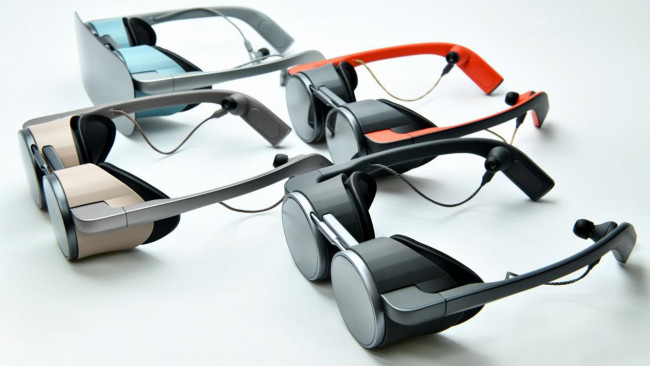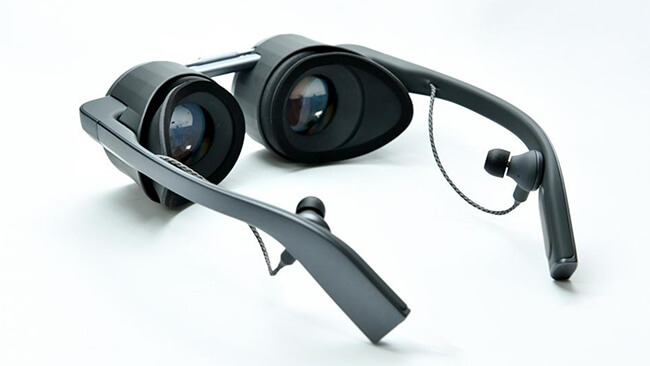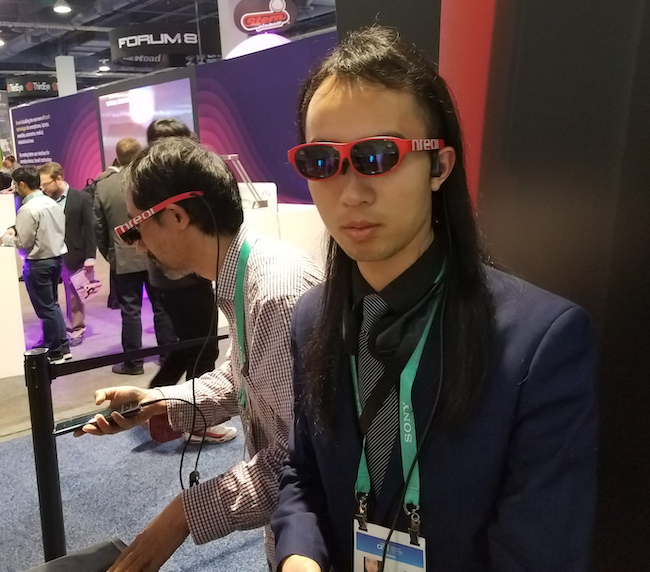AR and AR HMDs continue to improve, despite apparent indifference from the mass market

AR and VR were pretty big this year at CES. Here’s our look at two of the most promising new headsets that were on show, and what they mean for the immediate future of the technology.
Needless to say, there were dozens of companies at CES showing off AR/VR headsets or related technology. I certainly did not see or try them all, so I will highlight a VR and AR headset I did check out.
One of the most talked about was the new VR headset debuted by Panasonic, and fortunately, I was able to get an invitation to give it a try. It did not disappoint. While still a work in progress, the image quality was very good with no noticeable ghosting and good crispness even at the edges of the optics. This is also the first HDR-capable VR headset, says Panasonic.
Specs include a 70-degree diagonal field of view using two of Kopin’s 1” 2K x 2K double stack OLED-on-Silicon microdisplays. At CES, Kopin showed the first versions of their new 2.6K x 2.6K microdisplays which can be integrated into the Panasonic headset to offer a 100-degree FOV. One of the best ways to describe the image fidelity is pixels-per-degree (ppd). For a given imager, if you increase the field of view, you decrease the ppd, thus reducing resolution to the eye. Panasonic says their headset achieves a ppd of 26, which is better than most headsets but still short of 20-20 vision, which is 60 ppd.

Panasonic’s HDR1 capable UHD VR glasses. Image: Panasonic
The optics are referred to as the “K70 pancake optics”, which comes from 3M. The are indeed very compact allowing for the goggle-like form factor with high MTF. But they are also not very optically efficient only passing about 10% of the available light. Nevertheless, the Panasonic headset was bright enough (>100 nits to the eye) for a VR applications.
As you can see from the photo below, these are pretty big glasses that are a bit heavy on the nose. Panasonic realises this and will be thinking about how to better balance the weight going forward. Panasonic is adding its own audio and video processing along with a 5G interface in anticipation of how these VR glasses will be used in the near future. The glasses remain a project in development, with no announced commerialisation date.

Chinnock wearing Panasonic VR glasses.jpg
Nreal
An AR headset I was impressed with is the one being developed by Nreal. They plan to offer an eyeglasses style AR headset to consumers this winter for $499 – a very attractive price point. Developer kits are available now for $1200.
The lightweight (88 grams) headset, called Light, uses two 1080p micro-OLED imagers to create a 52-degree diagonal field of view and 400-500 nits to the eye. The optics are quite special offering a mixture of reflective and refractive elements that is about 30% optically efficient. The result is an image with 43 ppd making it more optically efficient and higher ppd than the Panasonic VR headset. However, I found the image quality of the Pancake optic to be superior.
The eyebox is also quite big at 12 x8 mm meaning you can easily see the image without having to adjust the separation between the two lens/display modules. And, with good eye relief, you can even wear your prescription glasses as well.
The headset design is also very nice with compute done in the smartphone via a USB type-C cable connection. Nreal work specifically with Qualcomm and the Snapdragon 845 mobile processor to optimise performance, but they can be connected to a tablet, PC or Nreal computing unit (with the Snapdragon 855 processor) as well. Smartphones are already offering 5G connectivity, allowing the headset to take advantage of this higher bandwidth and low latency feature.

Nreal glasses at CES 2020.jpg
Having decent hardware is obviously only part of the solution. Having a problem to solve, or new ways to be entertained needs to be a driving force behind adoption of AR in general. To help facilitate this, Nreal used CES to unveil their new Android-based O/S called Nebula. This is needed to launch 2D apps within the 3D visual interface and spatial computing platform of the Nreal headset. The headset also includes simultaneous localisation and mapping (SLAM) hardware and 6 DoF tracking to allow the accurate placement of virtual objects in 3D space.
Nebula, like the O/S on MagicLeap and Hololens platforms, allow users to keep multiple apps open and pinned in their personal space, with each screen being resizable.
Nreal is targeting consumer applications for AR. These are starting to emerge using your mobile phone to see the virtual objects in the real world while looking at your mobile phone. Nreal wants to add their headset as an accessory for viewing these virtual objects with much more immersion.
For example, at CES, they demonstrated a shopping application and watching a virtual TV. You can also use Finch’s 6-DoF controller and Black Shark’s gaming kit for entertainment applications.
Despite the progress, I am still not sure if consumers will find this compelling enough to spend $500, and if they will, continue to use the headset after 3 months. Plus, Nreal is locked in a legal battle with Magic Leap which claims the Nreal’s CEO, a former Magic Leap employee, stole certain technology and headsets designs.
It seems it is still early days for both VR and AR.
By Chris Chinnock

熱門頭條新聞
- Slow-Motion Collapse: How Nostalgia, Streaming, and Short-Sightedness Undermined Hollywood’s Future
- PBS NOVA / GBH JOINS THE PRODUCTION OF ZED AND ARTE’S PREMIUM DOCUMENTARY THE LOST TOMBS OF NOTRE-DAME
- Biopunk Action Title Sonokuni Launching Early 2025
- LifeAfter Season 7 “The Heronville Mystery” Brings a Brand New Folklore Horror Theme for a Unique Survival Experience
- 2024 Developer Showcase and look ahead to 2025
- Jumping Jazz Cats will launch on PC January 30th
- Lexar Announces Two Portable SSDs
- Quell Announces Hit Game Shardfall is Coming to VR
